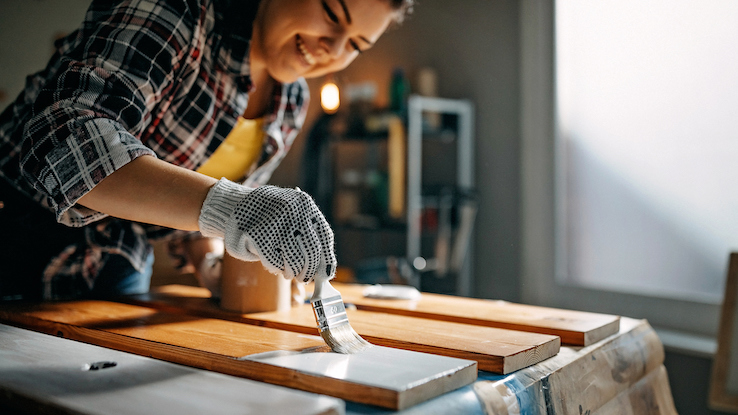What Paint Should I Use for Wood?

From the cabinets in your kitchen to a piece of furniture to a fun craft, there are plenty of wood items you can paint. And one of the best things about wood is that it accepts a variety of paints well, whether you opt for something that’s acrylic or an oil-based formula. Painting wood is an easy way to change its look and give it some new personality, but it’s not always clear what paint to use for different projects and applications. Here’s what you need to know about the right paint to use for wood.
What’s Your Project?
First, it’s essential to figure out the nature of your project, meaning you’ll need to determine not only what you’re painting but also where it’s located or going to be used. Are you painting shingles on the exterior of your home? Or are you painting an outdoor deck that’ll see a lot of foot traffic? How about kitchen cabinets that people will touch often, or a bathroom shelf that’ll be exposed to high humidity from the shower?
Knowing things like whether or not it’s going to get wet, how often someone’s going to use it or touch it and what overall effect or look you want to achieve are all essential for determining what paint you should use for the project. Wood accepts a very wide range of paints and stains, but each of those can have differing levels of durability and protection. Some paints are better than others in certain situations, and you’ll need to know your particular situation before you make your choice.
Paint Types and Formulas
The great thing about wood is that, as long as you apply primer to it in most cases, any type of paint works well on it, depending on what function you need your project to serve. Generally speaking, paints to use on wood are water-based or oil-based. Acrylic and latex are the two most common types of water-based paints, while oil-based paints fall into two categories: synthetic or natural. Each of these is better than others for specific applications.
Latex paint is quick-drying, easy to clean and better for the environment than other types. It’s also less likely to discolor over time. However, it’s not the most durable choice, as it can scratch and chip easily. It’s best for indoor wood items or surfaces that you won’t touch or use very often, such as rarely used furniture, storage cabinet doors, stair spindles and picture frames. Latex paint is often the most affordable type.
Acrylic paint is ideal for home exteriors, although you can also use oil-based paint here. If the exterior is made up of different materials, such as stone and wood, you’re better off choosing acrylic. Materials like stone and masonry need breathable paint to allow moisture and water vapor to pass through, and oil-based paint prevents this. Acrylic craft paints are also widely available and easy to use and clean up if you’re doing a simple DIY craft project using wood.
Synthetic oil paint, which is also called alkyd, is the best choice for applications where you need a lot more durability. Think everyday furniture that’ll get used and jostled often, kitchen and bathroom cabinets, interior trims like baseboards and door frames that’ll get kicked and touched often, and flooring indoors and out. Oil-based paints are more rigid than flexible, water-based types so they’re less likely to chip — even when people are walking on them — and they’re also easier to wash clean because of this.
Natural oil paint, called linseed, is best for craft projects on which you want to create a warm, aged patina. It’s typically much more expensive than the synthetic variety, which is why it’s best for smaller projects.
Prepping for the Project
To help the paint adhere well and to ensure the finish looks its best when everything is dry, it’s important to prep your wood to get it ready. If you’re painting an exterior surface or item, give everything a thorough wash to make sure there isn’t any dirt, dust, moss or algae, all of which can keep the paint from sticking to the surface. If you’re painting wood deck furniture, a table or something else for the outdoors that people will touch frequently, it’s a wise idea to sand it before painting to give the paint something smooth to adhere to. Splinters and cracks can also keep the finished product from looking its best, and they’re uncomfortable to sit on. Let the surface or or item dry out fully before applying the paint, and give it a few days to dry and start curing before you use it. It’s best to do outdoor wood-painting projects while the weather is nice.
If you’re repainting an interior surface or furniture such as kitchen cabinetry or a dresser, take a look at the existing paint or finish. If the item’s current paint isn’t chipped, cracked or bubbling, you can usually paint right over it; just sand the wood areas briefly to give the surface more texture for the paint to stick to. If you don’t need to remove cabinet paint, it’s still a good idea to clean the doors with a heavy-duty solution like TSP to eliminate all traces of grease and grime. If you do need to remove a little bit of paint, such as a few chipped areas, you can sand them down. However, you may need to use paint stripper for items with paint that’s very damaged. This is a product that softens the old paint so you can scrape and wipe it all off.
A word of caution here: If your cabinets or other painted home surfaces were last done in the 1970s or earlier, they may contain lead-based paint. If you use a testing kit and determine there’s lead in your paint, call the National Lead Information Center or your local health department to find out how to proceed.





